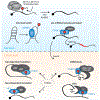Chemical Modifications in the Life of an mRNA Transcript
- PMID: 30230927
- PMCID: PMC6436393
- DOI: 10.1146/annurev-genet-120417-031522
Chemical Modifications in the Life of an mRNA Transcript
Abstract
Investigations over the past eight years of chemical modifications on messenger RNA (mRNA) have revealed a new level of posttranscriptional gene regulation in eukaryotes. Rapid progress in our understanding of these modifications, particularly, N6-methyladenosine (m6A), has revealed their roles throughout the life cycle of an mRNA transcript. m6A methylation provides a rapid mechanism for coordinated transcriptome processing and turnover that is important in embryonic development and cell differentiation. In response to cellular signals, m6A can also regulate the translation of specific pools of transcripts. These mechanisms can be hijacked in human diseases, including numerous cancers and viral infection. Beyond m6A, many other mRNA modifications have been mapped in the transcriptome, but much less is known about their biological functions. As methods continue to be developed, we will be able to study these modifications both more broadly and in greater depth, which will likely reveal a wealth of new RNA biology.
Keywords: N6-methyladenosine; RNA metabolism; epitranscriptome; ribonucleotide modifications.
Figures



Comment in
-
Multivalent m6A motifs promote phase separation of YTHDF proteins.Cell Res. 2019 Sep;29(9):767-769. doi: 10.1038/s41422-019-0210-3. Epub 2019 Aug 6. Cell Res. 2019. PMID: 31388144 Free PMC article. No abstract available.
References
-
- Adams JM, Cory S. 1975. Modified nucleosides and bizarre 5′-termini in mouse myeloma mRNA. Nature 255:28–33 - PubMed
Publication types
MeSH terms
Substances
Grants and funding
LinkOut - more resources
Full Text Sources
Other Literature Sources
Research Materials
Miscellaneous

